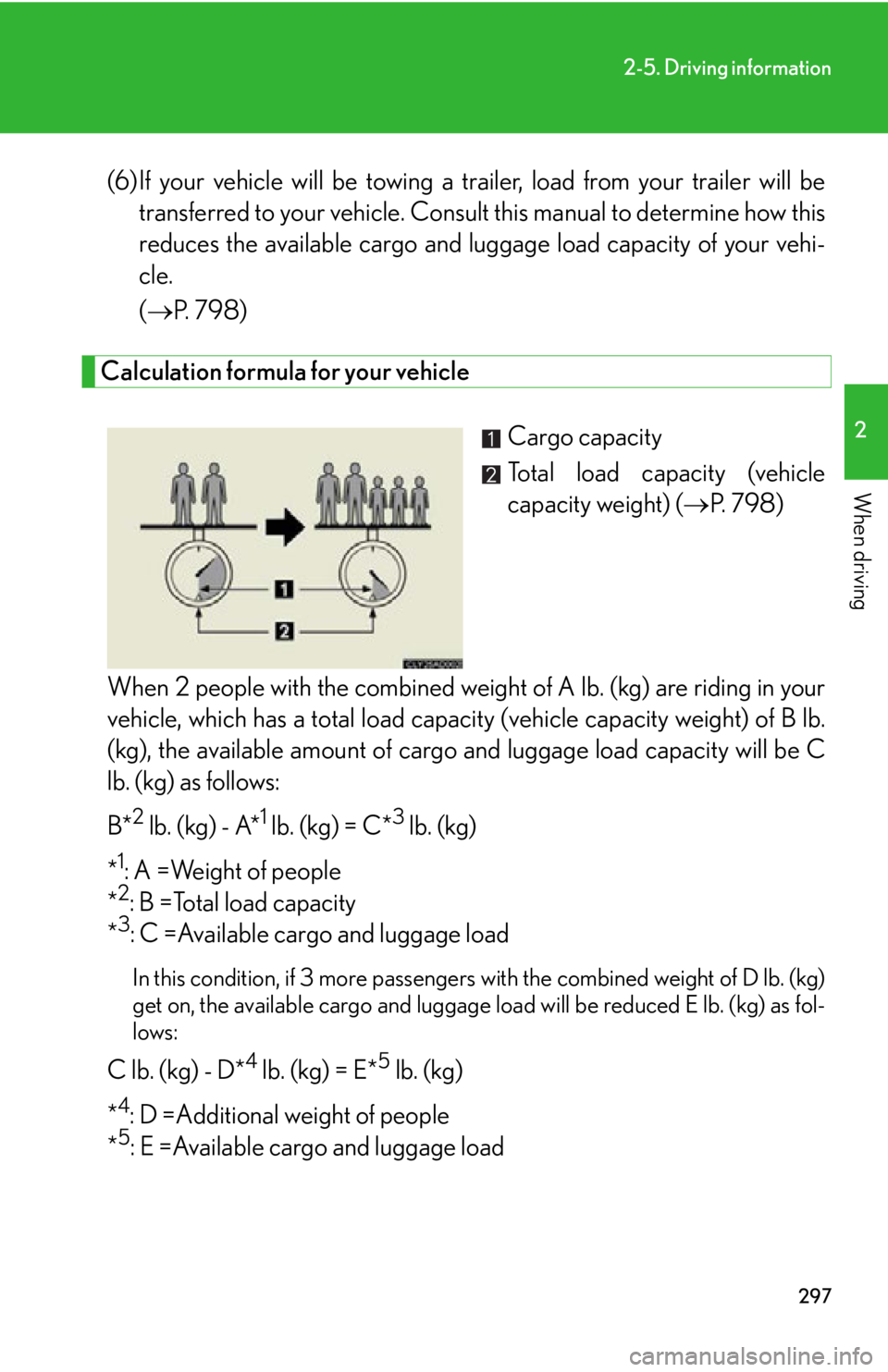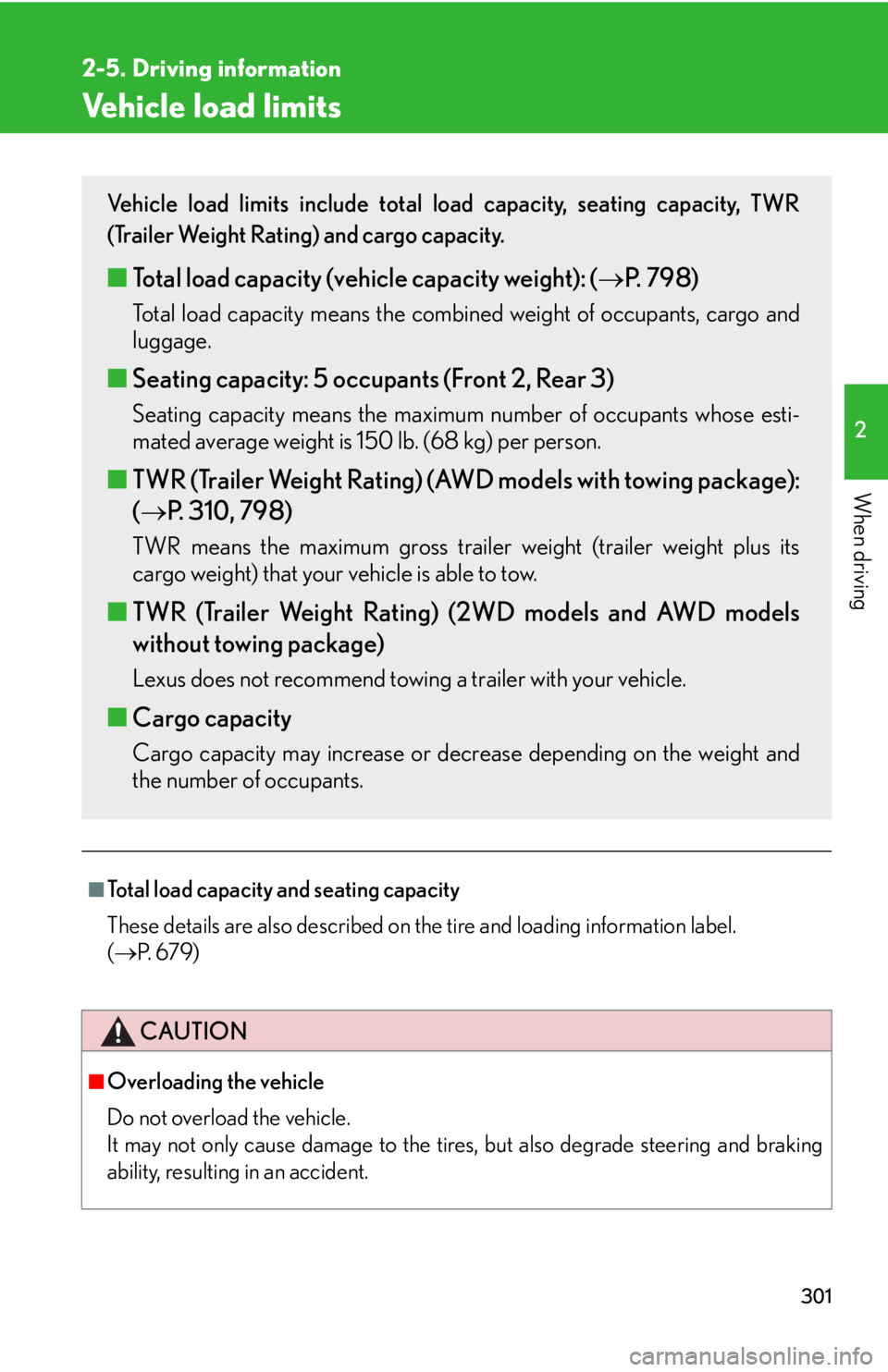Page 296 of 878

2962-5. Driving information
Cargo and luggage
Capacity and distribution
Cargo capacity depends on the to tal weight of the occupants.
(Cargo capacity) = (Total load capa city) — (Total weight of occupants)
Steps for Determining Correct Load Limit
(1) Locate the statement “The combined weight of occupants and cargo
should never exceed XXX kg or XXX lbs.” on your vehicle’s placard.
(2) Determine the combined weight of th e driver and passengers that will
be riding in your vehicle.
(3)Subtract the combined weight of the driver and passengers from
XXX kg or XXX lbs.
(4)The resulting figure equals the av ailable amount of cargo and luggage
load capacity.
For example, if the “XXX” amount equals 1400 lbs. and there will be
five 150 lb passengers in your ve hicle, the amount of available cargo
and luggage load capacity is 650 lbs. (1400 750 (5 150) = 650
lbs.)
(5)Determine the combined weight of luggage and cargo being loaded
on the vehicle. That weight may no t safely exceed the available cargo
and luggage load capacity calculated in Step 4. Take notice of the following information about storage precautions, cargo
capacity and load.
● Stow cargo and luggage in the luggage compartment whenever
possible.
● Be sure all items are secured in place.
● Be careful to keep the vehicle level. Placing the weight as far for-
ward as possible helps maintain vehicle balance.
● For better fuel economy, do not carry unnecessary weight.
Page 297 of 878

2972-5. Driving information
2
When driving (6)If your vehicle will be towing a trailer, load from your trailer will be
transferred to your vehicle. Consul t this manual to determine how this
reduces the available cargo and luggage load capacity of your vehi-
cle.
( P. 7 9 8 )
Calculation formula for your vehicle
Cargo capacity
Total load capacity (vehicle
capacity weight) ( P. 7 9 8 )
When 2 people with the combined weight of A lb. (kg) are riding in your
vehicle, which has a total load capacity (vehicle ca pacity weight) of B lb.
(kg), the available amount of cargo an d luggage load capacity will be C
lb. (kg) as follows:
B* 2
lb. (kg) - A* 1
lb. (kg) = C* 3
lb. (kg)
* 1
: A =Weight of people
* 2
: B =Total load capacity
* 3
: C =Available cargo and luggage load
In this condition, if 3 more passengers with the combined weight of D lb. (kg)
get on, the available cargo and luggage lo ad will be reduced E lb. (kg) as fol-
lows:
C lb. (kg) - D* 4
lb. (kg) = E* 5
lb. (kg)
* 4
: D =Additional weight of people
* 5
: E =Available cargo and luggage load
Page 298 of 878

2982-5. Driving information
As shown in the example above, if the number of occupants increases,
the cargo and luggage load will be re duced by an amount that equals the
increased weight due to the addition al occupants. In other words, if an
increase in the number of occupants ca uses an excess of the total load
capacity (combined weight of occupants plus cargo and luggage load),
you must reduce the cargo and luggage on your vehicle. CAUTION■
Things that must not be carri ed in the luggage compartment
The following things may cause a fire if loaded in the luggage compartment: ●
Receptacles containing gasoline●
Aerosol cans■
Storage precautions
Observe the following precautions.
Failure to do so may result in death or serious injury. ●
Stow cargo and luggage in the lugga ge compartment whenever possible.●
Do not stack cargo and luggage in the luggage compartment higher than the
seatbacks.
Such items may be thrown about and possib ly injure people in the vehicle in the
event of sudden braking or in an accident.●
Do not place cargo or luggage in or on the following locations as the items may
get under the brake or accelerator pedal and prevent the pedals from being
depressed properly, block the driver’s vision, or hit the driver or passengers,
causing an accident:
• At the feet of the driver
• On the front passenger or rear seats (when stacking items)
• On the luggage cover
• On the instrument panel
•On the dashboard
●
Secure all items in the occupant compartment, as they may shift and injure some-
one in the event of sudden braking, sudden swerving or an accident.
Page 301 of 878

3012-5. Driving information
2
When driving Vehicle load limits
■
Total load capacity and seating capacity
These details are also described on th e tire and loading information label.
( P. 6 7 9 )
CAUTION
■
Overloading the vehicle
Do not overload the vehicle.
It may not only cause damage to the tire s, but also degrade steering and braking
ability, resulting in an accident. Vehicle load limits include total load capacity, seating capacity, TWR
(Trailer Weight Rating) and cargo capacity.
■ Total load capacity (vehicle capacity weight): ( P. 7 9 8 )Total load capacity means the combined weight of occupants, cargo and
luggage.
■ Seating capacity: 5 occupants (Front 2, Rear 3) Seating capacity means the maximum number of occupants whose esti-
mated average weight is 150 lb. (68 kg) per person.
■ TWR (Trailer Weight Rating) (AWD models with towing package):
( P. 310, 798)TWR means the maximum gross trailer weight (trailer weight plus its
cargo weight) that your vehicle is able to tow.
■ TWR (Trailer Weight Rating) (2WD models and AWD models
without towing package) Lexus does not recommend towing a trailer with your vehicle.
■ Cargo capacity Cargo capacity may increase or decrease depending on the weight and
the number of occupants.
Page 306 of 878

3062-5. Driving information
Trailer towing (AWD models with towing package)
Towing related terms
■ GCWR (Gross Combination Weight Rating)
The maximum allowable gross
combination weight. The gross
combination weight is the sum of
the total vehicle weight (including
the occupants, cargo and any
optional equipment installed on
the vehicle) and the weight of the
trailer being towed (including the
cargo in the trailer).Your vehicle is designed primarily as a passenger-and-load-carrying vehi-
cle. Towing a trailer can have an adverse impact on handling, performance,
braking, durability, and fuel consumpt ion. For your safety and the safety of
others, you must not overload your vehicle or trailer. You must also ensure
that you are using appropriate towing equipment, that the towing equip-
ment has been installed correctly and used properly, and that you employ
the requisite driving habits.
Vehicle-trailer stability and braking performance are affected by trailer
stability, brake performance and settin g, trailer brakes, the hitch and hitch
systems (if equipped).
To tow a trailer safely, use extreme care and drive the vehicle in accor-
dance with your trailer’s characteristics and operating conditions.
Lexus warranties do not apply to damage or malfunction caused by towing
a trailer for commercial purposes.
Contact your Lexus dealer for furt her information about additional
requirements such as towing kits, etc.
Page 307 of 878
3072-5. Driving information
2
When driving ■ GVWR (Gross Vehicle Weight Rating)
The maximum allowable gross
vehicle weight. The gross vehicle
weight is the total weight of the
vehicle. When towing a trailer, it is
the sum of the vehicle weight
(including the occupants, cargo
and any optional equipment
installed on the vehicle) and the
tongue weight.
■ GAWR (Gross Axle Weight Rating)
The maximum allowable gross axle
weight. The gross axle weight is the
load placed on each axle (front
and rear).Front GAWR
Rear GAWR
Page 308 of 878
3082-5. Driving information
■ TWR (Trailer Weight Rating)
The maximum allowable gross
trailer weight. The gross trailer
weight is the sum of the trailer
weight and the weight of the cargo
in the trailer.
TWR is calculated assuming base
vehicle with one driver, one front
passenger, towing package (if
available), hitch and hitch systems
(if required). Additional optional equipment,
passengers and cargo in the vehi-
cle will reduce the trailer weight
rating so as not to exceed GCWR,
GVWR and GAWR.
If the gross trailer weight exceeds
3000 lb. (1360 kg), it is recom-
mended to use a trailer with 2 or
more axles.
■ Unbraked TWR (Unbraked Trailer Weight Rating)
The trailer weight rating for towing
a trailer without a trailer service
brake system.(With brakes)
(Without brakes)
Page 310 of 878
3102-5. Driving information
GCWR, TWR, Unbraked TWR, Fifth wheel and Gooseneck towing TWR
Confirm that the gross trailer weight , gross combination weight, gross
vehicle weight, gross axle weight and tongue weight are all within the lim-
its.
■ GCWR
* and TWR
*
■ Unbraked TWR
*1000 lb. (453 kg)
* : These models meet the tow-vehicle trailering requirement of SAE Interna-
tional per SAE J2807. To w i n g t y p e Driving system GCWR TWR
With towing package AW D 9480 lb.
(4297 kg) 3500 lb.
(1588 kg)